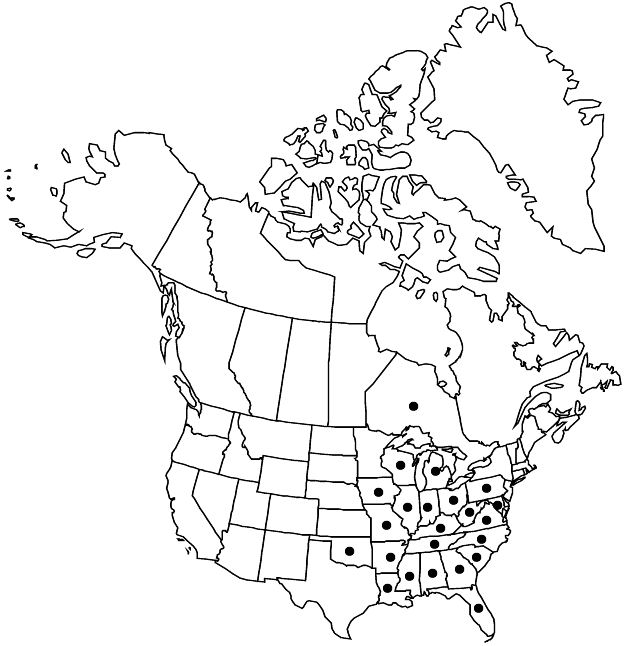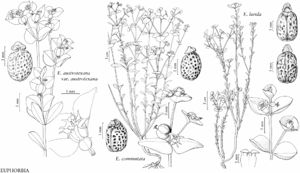Difference between revisions of "Euphorbia commutata"
in A. Gray, Manual ed. 2, 389. 1856.
FNA>Volume Importer |
imported>Volume Importer |
||
| (5 intermediate revisions by 2 users not shown) | |||
| Line 1: | Line 1: | ||
{{Treatment/ID | {{Treatment/ID | ||
|accepted_name=Euphorbia commutata | |accepted_name=Euphorbia commutata | ||
| − | |accepted_authority=Engelmann | + | |accepted_authority=Engelmann |
|publications={{Treatment/Publication | |publications={{Treatment/Publication | ||
| − | |title=Manual ed. | + | |title=in A. Gray, Manual ed. |
|place=2, 389. 1856 | |place=2, 389. 1856 | ||
|year=1856 | |year=1856 | ||
| Line 10: | Line 10: | ||
|special_status={{Treatment/ID/Special_status | |special_status={{Treatment/ID/Special_status | ||
|code=F | |code=F | ||
| − | |label= | + | |label=Illustrated |
}}{{Treatment/ID/Special_status | }}{{Treatment/ID/Special_status | ||
|code=E | |code=E | ||
| Line 19: | Line 19: | ||
|name=Galarhoeus austrinus | |name=Galarhoeus austrinus | ||
|authority=(Small) Small | |authority=(Small) Small | ||
| + | |rank=species | ||
}} {{Treatment/ID/Synonym | }} {{Treatment/ID/Synonym | ||
|name=G. commutatus | |name=G. commutatus | ||
|authority=(Engelmann) Small ex Rydberg | |authority=(Engelmann) Small ex Rydberg | ||
| + | |rank=species | ||
}} {{Treatment/ID/Synonym | }} {{Treatment/ID/Synonym | ||
|name=Tithymalus commutatus | |name=Tithymalus commutatus | ||
|authority=(Engelmann) Klotzsch & Garcke | |authority=(Engelmann) Klotzsch & Garcke | ||
| + | |rank=species | ||
}} | }} | ||
|hierarchy=Euphorbiaceae;Euphorbia;Euphorbia subg. Esula;Euphorbia commutata | |hierarchy=Euphorbiaceae;Euphorbia;Euphorbia subg. Esula;Euphorbia commutata | ||
| Line 48: | Line 51: | ||
-->{{#Taxon: | -->{{#Taxon: | ||
name=Euphorbia commutata | name=Euphorbia commutata | ||
| − | + | |authority=Engelmann | |
| − | |authority=Engelmann | ||
|rank=species | |rank=species | ||
|parent rank=subgenus | |parent rank=subgenus | ||
| Line 60: | Line 62: | ||
|distribution=Ont.;Ala.;Ark.;Fla.;Ga.;Ill.;Ind.;Iowa;Ky.;La.;Md.;Mich.;Miss.;Mo.;N.C.;Ohio;Okla.;Pa.;S.C.;Tenn.;Va.;W.Va.;Wis. | |distribution=Ont.;Ala.;Ark.;Fla.;Ga.;Ill.;Ind.;Iowa;Ky.;La.;Md.;Mich.;Miss.;Mo.;N.C.;Ohio;Okla.;Pa.;S.C.;Tenn.;Va.;W.Va.;Wis. | ||
|reference=None | |reference=None | ||
| − | |publication title=Manual ed. | + | |publication title=in A. Gray, Manual ed. |
|publication year=1856 | |publication year=1856 | ||
| − | |special status= | + | |special status=Illustrated;Endemic |
| − | |source xml=https:// | + | |source xml=https://bitbucket.org/aafc-mbb/fna-data-curation/src/2e0870ddd59836b60bcf96646a41e87ea5a5943a/coarse_grained_fna_xml/V12/V12_361.xml |
|genus=Euphorbia | |genus=Euphorbia | ||
|subgenus=Euphorbia subg. Esula | |subgenus=Euphorbia subg. Esula | ||
Latest revision as of 19:15, 5 November 2020
Herbs, usually biennial, occasionally annual, with taproot. Stems erect or ascending, decumbent and often branched near base, 10–40 cm, glabrous. Leaves: petiole usually 5–10 mm, 0–1 mm distally; blade usually oblanceolate to obovate, rarely ovate, 5–30 × 3–10 mm, base broadly attenuate, margins entire, apex usually obtuse to rounded, occasionally slightly retuse, surfaces glabrous; venation pinnate, midvein prominent. Cyathial arrangement: terminal pleiochasial branches (2–)3(–4), 1–3+ times 2-branched; pleiochasial bracts similar in shape and size to distal leaves; dichasial bracts distinct to basally subconnate, not imbricate, widely ovate, rhombic, or reniform, base cordate, rarely slightly perfoliate, margins entire, apex obtuse to rounded, mucronulate; axillary cymose branches 0–5. Cyathia: peduncle 0.5–1 mm. Involucre campanulate, 1.7–2.5 × 1.5–2.5 mm, glabrous; glands 4, crescent-shaped; 0.6–1 × 0.8–1.5 mm; horns divergent, 0.5–1.1 mm. Staminate flowers 9–15. Pistillate flowers: ovary glabrous; styles 0.9–1.3 mm, 2-fid. Capsules ovoid-globose, 2.5–3.2 × 3 mm, slightly lobed; cocci rounded to ± flattened, smooth, glabrous; columella 1.5–2 mm. Seeds white to gray, broadly oblong-elliptic to ovoid or nearly globose, 1.5–2 × 1.3–1.6 mm, strongly small-pitted; caruncle irregularly winglike, conic, 0.6–1 × 0.7–0.9 mm.
Phenology: Flowering and fruiting spring–summer.
Habitat: Bottomland and upland forests, bluffs and ledges, stream banks, glades, rarely fen margins.
Elevation: 50–1000 m.
Distribution

Ont., Ala., Ark., Fla., Ga., Ill., Ind., Iowa, Ky., La., Md., Mich., Miss., Mo., N.C., Ohio, Okla., Pa., S.C., Tenn., Va., W.Va., Wis.
Discussion
Selected References
None.
